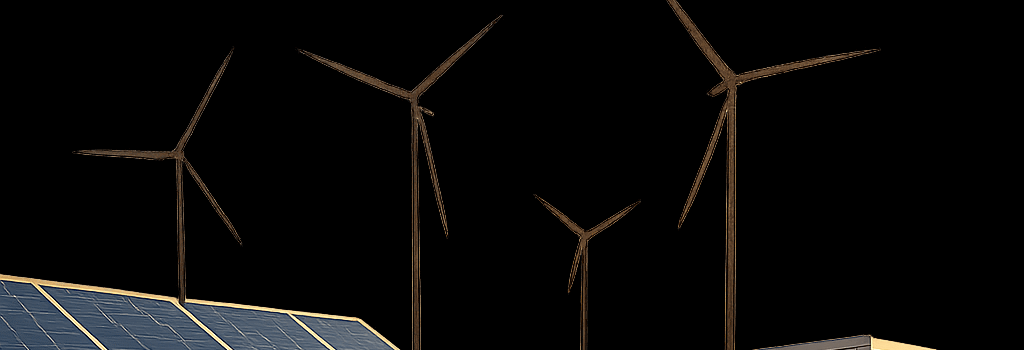Renewables Surge: Solar, Wind & Storage Lead U.S. Power Plants

Updated Analysis (2025): In the first half of 2025, the United States commissioned over 22 GW of new generation capacity—overwhelmingly in utility-scale solar, onshore wind, and battery energy storage. This trend reinforces the accelerating clean-energy transition, shaped by technology advances, policy incentives like the Inflation Reduction Act (IRA), and evolving grid requirements.
Key Data on New Additions (H1 2025)
- Total Capacity: 22,332 MW of summer-rated capacity added.
- Breakdown by Technology:
- Solar PV: 12,034 MW (54%)
- Battery Energy Storage (BESS): 5,900 MW (26%)
- Onshore Wind: 2,697 MW (12%)
- Natural Gas (combined-cycle & peakers): 1,691 MW (8%)
- No new coal or large-scale nuclear units.
- Largest Project: 600 MW Hornet Solar, Swisher County, Texas, featuring bifacial modules and a tracking system (1.8 GSWh/yr).
Policy Landscape & Project Timelines
Many projects came online after 3–5 years of development, spurred by:
- IRA Incentives: 30% investment tax credit (ITC) for solar/battery paired systems, plus bonus credits for domestic content and energy communities.
- State RPS Mandates: Renewable Portfolio Standards in CA, NY, TX, and 30+ other states pushing >50% clean by 2030.
- Improved Permitting: Federal grid-enhancing transmission line approvals and DOE’s Grid Deployment Office funding.
“The inertia in the system favors projects already in the queue. The true test will be whether new IRA sunsets or supply-chain disruptions slow down the momentum,” said Dr. David Victor, Innovation & Public Policy Professor at UCSD.
Technical Performance & Grid Integration
- Capacity Factors:
- Combined-cycle Gas: ~60%
- Onshore Wind: ~35–40%
- Utility-scale Solar PV: ~23–28%
- Storage Role: Lithium-ion BESS now offering 4-hour duration at C-rate ≤0.25C, providing frequency regulation, voltage support (4 VAr/VA), and peak shaving.
- Interconnection Challenges: 1,200 GW in ISO/RTO queues, facing network upgrades, HVDC corridor constraints, and NERC reliability standards compliance.
Deeper Analysis
1. Transmission & Distribution Bottlenecks
Large renewable clusters in the Midwest and California endure Tier 1 and Tier 2 transmission queue delays. New high-voltage lines (±500 kV DC) are under construction to alleviate congestion. Project developers are increasingly adopting grid-forming inverters with droop control algorithms to ensure synthetic inertia and dynamic voltage support.
2. Supply Chain Resilience & Material Sourcing
Critical minerals like lithium, nickel, and cobalt face global supply pressures. U.S. projects are leveraging:
- Domestic Mining Initiatives: Tax credits for cobalt/nickel processing under IRA.
- Recycling Programs: Hydrometallurgical recovery of Li-ion battery cathodes (studies show 95% recovery rates).
- Alternative Chemistries: Iron-based LFP cells for grid-scale, offering longer cycle life (7,000 cycles) at lower cost.
3. Market Dynamics & Forecasts
According to the EIA’s 2025 Annual Outlook, through 2030 the U.S. has:
- 120,269 MW solar PV (54% of planned capacity)
- 65,051 MW BESS (29%)
- 35,081 MW natural gas (16%)
- 0 MW coal; 1 GW nuclear (TerraPower Natrium at Kemmerer, WY, X-driven fast reactor design, projected 65% thermal efficiency)
Even with 2.5 TW installed base, capacity factors and dispatchability remain critical. Hybrid plants combining solar + BESS + gas peaker turbines are emerging to meet 24/7 clean energy targets.
Future Outlook & Emerging Technologies
Green Hydrogen: 500 MW PEM electrolyzer pilots under DOE’s H2Hubs program aim to store excess solar for seasonal balancing. Export markets in South Korea and EU drive electrolyzer scaling.
Advanced Nuclear: TerraPower’s Natrium and X-energy’s Xe-100 small modular reactors target load-following with rapid power ramp rates (±5% per minute) to complement variable renewables.
Pumped Hydro & CAES: New pumped storage projects in CA & NY (1–1.5 GW, 8–12 hr duration) and Pressurized Adiabatic Compressed Air Energy Storage (A-CAES) prototypes.
Conclusions
The near-term U.S. energy buildout clearly favors solar, wind, and storage, reflecting cost declines (LCOE: solar $28–35/MWh, onshore wind $30–40/MWh, BESS $150–200/kWh) and robust policy support. While natural gas remains a hedge for dispatchable power, its growth is tempered by fuel price volatility, supply-chain hurdles, and decarbonization commitments.
“As grid operators adapt to high renewable penetration, we’re seeing unprecedented coordination between ISOs, DOE research, and private capital to ensure system reliability,” noted Ric O’Connell, Executive Director at GridLab.